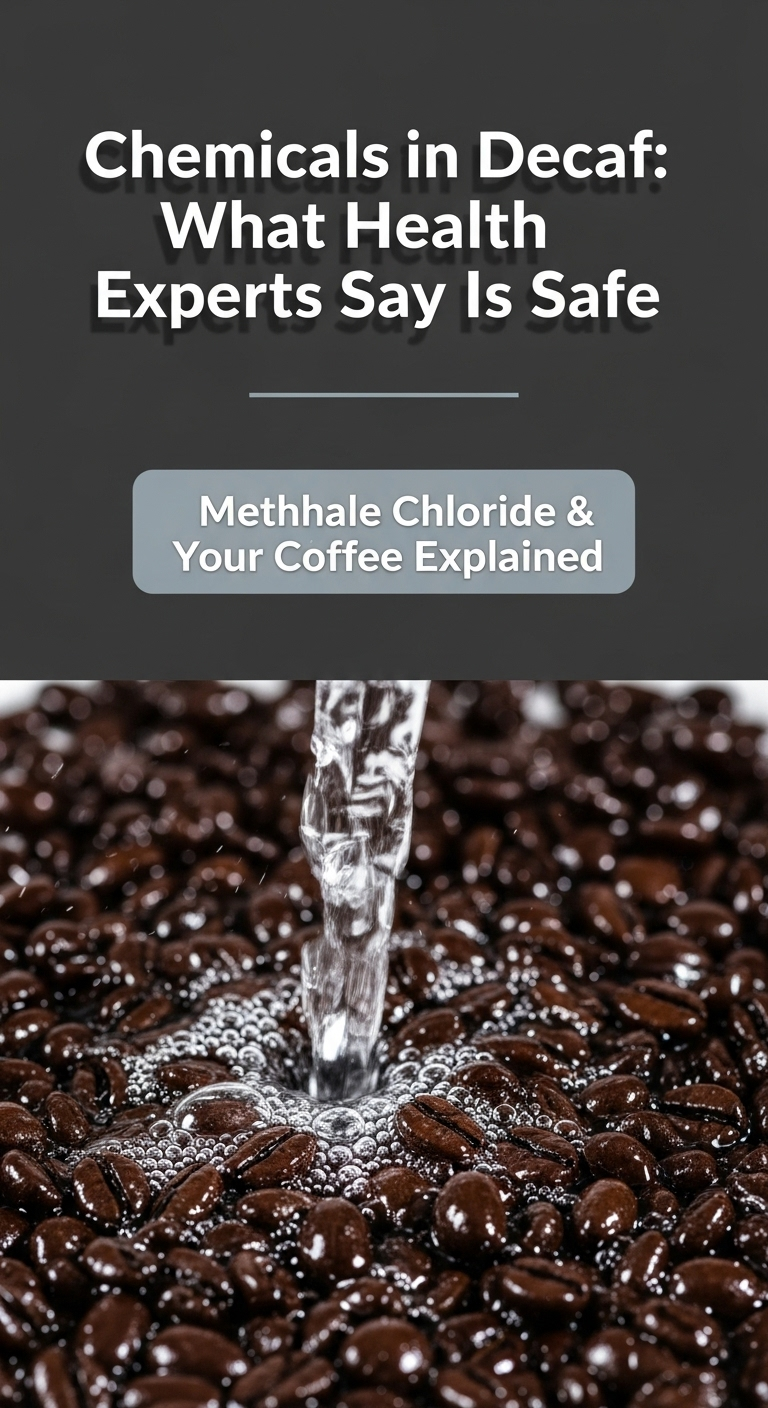As an Amazon Associate CoffeeXplore.com earns from qualifying purchases.
Chemicals in Decaf: What Health Experts Say Is Safe
That evening cup of decaf is a comforting ritual, but have you ever wondered what was taken out—and how? You’re not alone in questioning if the chemicals used to decaffeinate coffee are harmful, especially when you hear terms like “paint stripper” associated with the process. This guide is here to cut through the confusion and deliver the facts.
While regulatory bodies like the FDA consider the trace chemical levels in decaf coffee safe, ongoing debate and the availability of chemical-free alternatives lead many health-conscious consumers to seek specific decaffeination processes. Leveraging extensive analysis of industry data and expert opinions, this guide unpacks the different methods, the science behind the safety debate, and how you can confidently choose a decaf coffee that aligns with your health standards.
Key Facts
- Probable Carcinogen Classification: The most common chemical solvent, methylene chloride, is classified as a probable human carcinogen by authoritative bodies like the Environmental Protection Agency (EPA) and the World Health Organization (WHO).
- Strict FDA Limit: The FDA permits the use of methylene chloride in decaffeination but sets a strict maximum residue limit of 10 parts per million (ppm), a level considered safe for consumption based on current scientific evidence.
- Chemical-Free Alternatives Exist: Processes like the Swiss Water Process and the CO2 Process remove caffeine without the use of any added chemical solvents, relying solely on water, carbon filters, or natural carbon dioxide.
- Labeling is Not Mandatory: Coffee brands are not legally required to disclose which decaffeination method they use on their packaging, making it difficult for consumers to know if solvents were involved.
- Organic Certification Prohibits Solvents: A key indicator of a chemical-free process is the “USDA Organic” seal, as organic standards prohibit the use of synthetic solvents like methylene chloride.
The Real Story on Chemicals in Decaf: Are They Harmful?
The core of the issue of whether the chemicals used to decaffeinate coffee are harmful boils down to a conflict between regulatory assurance and consumer concern. On one hand, government agencies set limits they deem safe. On the other, health advocates question why any amount of a potentially hazardous chemical should be in our food at all, especially when safer methods exist.
While regulatory bodies like the FDA consider the trace chemical levels in decaf coffee safe, ongoing debate and the availability of chemical-free alternatives lead many health-conscious consumers to seek specific decaffeination processes.
This article will break down exactly what those processes are, what the health debate truly entails, and how you can become an expert at choosing the decaf that’s right for you. We’ll look at the facts, the science, and the labels to give you complete confidence in your next cup.

Understanding the Decaffeination Processes: Solvent vs. Chemical-Free
Decaffeination falls into two main categories: solvent-based methods using chemicals like methylene chloride or ethyl acetate, and chemical-free methods like the Swiss Water Process or CO2 Process, which use only water or carbon dioxide. Understanding the difference is the first step to making an informed choice about the decaf you drink.
Think of it like two paths to the same goal: one uses a chemical key to unlock caffeine, the other uses a natural water-based lockpick. Both can be effective, but the tools they use are fundamentally different. To help you clearly see these differences, we’ve broken down the four primary methods used in the industry today.
| Method | Chemicals Used | Safety Notes (from inputs) | How to Identify |
|---|---|---|---|
| Methylene Chloride | Methylene Chloride (Dichloromethane) | A probable human carcinogen. FDA permits residues up to 10 ppm. High exposure can cause neurological effects and organ damage. | Rarely disclosed. Often referred to as the “European Method” or “Traditional Method.” |
| Ethyl Acetate | Ethyl Acetate | Often marketed as “natural.” Can be an irritant. Commercial versions are often synthetic and petroleum-based. | Sometimes labeled as “naturally decaffeinated” or “sugarcane process.” |
| Swiss Water Process | None (only water & carbon filters) | 100% chemical-free. Considered the gold standard for purity. Preserves coffee’s original flavor. | Brands proudly label their products with the “Swiss Water Process” logo. |
| CO2 Process | Carbon Dioxide (used as a liquid) | A natural and reusable solvent that is highly selective for caffeine. Considered a chemical-free method. | Sometimes disclosed by specialty coffee roasters. Also falls under “solvent-free” claims. |
The Solvent-Based Methods: Methylene Chloride and Ethyl Acetate
Solvent-based methods use chemicals like Methylene Chloride (a probable carcinogen also used in paint strippers) or Ethyl Acetate to directly bind with and remove caffeine from coffee beans. These are often called “direct-solvent” methods because the chemical directly touches the coffee beans.
Methylene Chloride: This is the most controversial chemical used in decaffeination. Its industrial uses and health classifications are the primary source of concern for consumers.
* Other Industrial Uses: It’s a powerful chemical solvent also found in paint strippers, paint removers, and metal cleaners.
* Health Classification: The Environmental Protection Agency (EPA) and the World Health Organization (WHO) classify methylene chloride as a probable human carcinogen.
* Health Risks (High Exposure): Direct, high-level exposure is known to cause neurological effects like drowsiness and dizziness, as well as potential injury to the liver and heart. This is why its use has been banned by the EPA for most industrial applications.
Ethyl Acetate: This solvent is often presented as a more “natural” alternative, but that label can be misleading.
* “Natural” Source: Ethyl acetate is a compound found naturally in fruits like bananas, which is why it’s sometimes associated with the “sugarcane process.”
* Synthetic Reality: Quick Fact: “Ethyl acetate is often marketed as ‘natural’ because it’s found in fruit, but the version used commercially is often a synthetic, petroleum-based chemical.”
* Health Effects: While considered less hazardous than methylene chloride, high exposure can still cause irritation to the eyes, skin, and throat. It is also the primary ingredient in many nail polish removers.
The Chemical-Free Alternatives: Swiss Water, CO2, and Mountain Water
Chemical-free methods like the Swiss Water Process use a caffeine-free green coffee extract and carbon filters to remove caffeine, while the CO2 process uses pressurized carbon dioxide as a natural, selective solvent. These methods are prized for their ability to remove caffeine without introducing any foreign chemical substances into the process.
Ever wonder how they get caffeine out without chemicals? The Swiss Water Process is a clever trick using a flavor-charged water solution and a special carbon filter. Here’s a simplified look at how it works:
- Create Flavor-Charged Water: A batch of green coffee beans is soaked in pure hot water. This water absorbs both the caffeine and the soluble flavor compounds from the beans. This initial batch of beans is discarded.
- Filter Out the Caffeine: The resulting solution, now called Green Coffee Extract (GCE), is passed through a series of activated carbon filters. These filters are specifically designed to trap the larger caffeine molecules while allowing the smaller, flavor-rich compounds to pass through.
- Decaffeinate New Beans: The now caffeine-free GCE is used to wash a new batch of green coffee beans. Since the water is already saturated with all the coffee flavor compounds, it can’t absorb any more flavor from the new beans. However, it can absorb the caffeine.
- Repeat: The caffeine flows from the beans into the GCE until the beans are 99.9% caffeine-free. The process preserves the coffee’s original character and flavor without the use of any added chemicals.
The CO2 Process and Mountain Water Process operate on similar principles of using natural elements—pressurized carbon dioxide or pure glacier water—to selectively remove caffeine while leaving the bean’s precious flavor profile as intact as possible. The main benefit and selling point for all these methods is the complete and total avoidance of added chemical solvents.
The Health Debate: Is Methylene Chloride Decaffeination Safe?
The FDA and National Coffee Association state the trace amounts of methylene chloride (under 10 ppm) in decaf are safe, while health groups argue that any amount of a probable carcinogen is unacceptable and should be banned. This is the central conflict.
So, how can a chemical be banned for paint strippers but allowed in your coffee? It all comes down to one word: dose. Health regulators and industry scientists argue that the amount of methylene chloride that might remain on a roasted coffee bean is exceptionally tiny—far below the levels known to cause harm.
The official stance from groups like the National Coffee Association (NCA) is clear: “Scientific evidence shows decaf coffee, including that processed with methylene chloride, is safe and associated with health benefits.” This position is supported by the FDA’s allowance of up to 10 parts per million, with industry data suggesting actual levels are often far lower.
However, health advocacy organizations like the Environmental Defense Fund and the Clean Label Project present a powerful counterargument rooted in a principle of preventative safety.
These groups have formally petitioned the FDA to ban methylene chloride from all food use, including decaffeination. They cite the Delaney Clause, a provision in U.S. food law that historically required the banning of any food additive found to cause cancer in humans or animals, regardless of the dose. They argue that because safer, chemical-free alternatives are widely available, there is no reason to accept any level of risk from a probable carcinogen.
Experts like Professor Oliver Jones of RMIT University have stated that toxicity is entirely dependent on the dose, and the levels found in a cup of decaf coffee are extremely low and unlikely to pose a risk. Yet, the concern persists for many consumers, especially those in vulnerable groups like pregnant women or individuals with pre-existing health conditions.
Your Guide to Choosing Safe, Chemical-Free Decaf Coffee in 2025
For consumers who decide to avoid solvent-processed decaf, the good news is that you have more power and options than ever before. You just need to know what to look for.
To ensure your decaf is chemical-free, look for labels explicitly stating “Swiss Water Process,” “CO2 Process,” “Solvent-Free,” or “Certified Organic.” You can also use tools like CheckYourDecaf.org to verify specific brands. Here is a simple checklist to empower your next purchase.
- 1. Look for Key Labels: The easiest way to identify a chemical-free decaf is through on-package certification. Brands pay to use these processes and are usually proud to advertise it. Look for:
- The official Swiss Water Process logo.
- The USDA Organic seal. Pro Tip: Since brands aren’t required to disclose their method, a ‘Certified Organic’ label is often a great shortcut. Organic standards prohibit the use of synthetic solvents like methylene chloride.
- Phrases like “Solvent-Free,” “Chemical-Free,” or “Water Processed.”
- 2. Use Online Tools: Non-profit organizations have done the work for you. The Clean Label Project runs a website called CheckYourDecaf.org, which lists major coffee brands and specifies whether or not their testing found methylene chloride residues. This is a powerful tool for checking brands that aren’t clearly labeled.
-
3. Contact the Company Directly: If you have a favorite brand and can’t find the information on the package or online, reach out. Send an email or contact them on social media and ask directly: “What process do you use to decaffeinate your coffee?” A transparent company should be happy to provide a clear answer.
Making an informed choice has never been easier, and having the right chemical-free decaf on hand ensures you can enjoy your coffee with peace of mind. To simplify your search, you can explore a curated selection of top-rated, chemical-free decaf coffees that meet the highest standards for purity and taste.
FAQs About are the chemicals used to decaffeinate coffee harmful
Is there a decaf coffee that is not toxic?
Yes, decaf coffee made using the Swiss Water Process, CO2 Process, or Mountain Water Process is considered non-toxic as these methods do not use chemical solvents. These processes rely on natural elements like water, carbon filters, and carbon dioxide to remove caffeine, ensuring no chemical residues are left on the beans.
What are the side effects of methylene chloride in coffee?
Direct, high-level exposure to methylene chloride can cause drowsiness, dizziness, and organ damage. However, health experts state the trace amounts found in decaf coffee are extremely low and unlikely to pose a risk. The side effects associated with the chemical, such as neurological issues or organ toxicity, are linked to industrial-level exposure, not the negligible residues that may be present after roasting.
What coffee companies do not use chemicals to decaffeinate their coffee?
While a comprehensive list is difficult as labeling isn’t mandatory, some brands like Peet’s Coffee explicitly state they use a water process, and brands like Natural Force market their decaf as consciously toxin-free. The most reliable way to find such brands is to look for the “Swiss Water Process” or “USDA Organic” logos on the packaging.
Does all decaf coffee have formaldehyde?
No. The FDA banned the use of formaldehyde in the U.S. production of decaffeinated coffee before 1985. Modern methods do not use this chemical. This is a common misconception rooted in outdated practices. Contemporary decaffeination, whether solvent-based or chemical-free, does not involve formaldehyde.
Is decaf coffee bad for pregnancy?
While the FDA deems all decaf safe, many experts recommend that pregnant women, or anyone concerned about chemical exposure, choose decaf made with a certified chemical-free method like the Swiss Water Process to eliminate any potential risk. This cautious approach helps provide peace of mind during a sensitive time by completely avoiding any debate over trace chemical safety.
Final Summary: Making an Informed Choice About Your Decaf
Navigating the world of decaf coffee doesn’t have to be confusing. While there is a legitimate scientific and consumer debate around the use of chemicals like methylene chloride, the power to choose ultimately rests in your hands. The evidence suggests that the risk from solvent-processed decaf is extremely low, but the existence of completely chemical-free alternatives offers a simple solution for anyone with concerns.
Here are the most critical takeaways to remember:
* The FDA considers decaf processed with methylene chloride safe, with residues far below official limits.
* Health advocates argue that no level of a probable carcinogen is acceptable when 100% chemical-free alternatives are available.
* The Swiss Water, CO2, and Mountain Water processes are verified chemical-free methods.
* Looking for “USDA Organic” or “Swiss Water Process” labels is the easiest way to ensure your decaf is solvent-free.
Now you have the facts. The next time you reach for decaf, whether at the grocery store or your favorite café, you can confidently ask the right questions and choose the cup that’s right for you and your health philosophy.
Last update on 2025-12-12 / Affiliate links / Images from Amazon Product Advertising API

